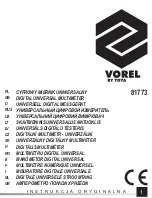
ELCART
ELCART DISTRIBUTION SPA via Michelangelo Buonarroti, 46 - 20093 Cologno Monzese (Milano) ITALY
Tel. +39 02.25117310 Fax +39 02.25117610 sito internet: www.elcart.com e-mail: info@elcart.it
Manuale di istruzioni/Scheda tecnica
La divulgazione dei dati contenuti in questa scheda è da ritenersi un servizio puramente informativo e non costituisce alcun vincolo da parte della Elcart in merito a prestazioni ed utilizzo del prodotto.
The divulgation of data contained on this technical sheet are exclusively for informational reasons and establish no link on behalf of Elcart regard to thr performances and the usa of the product.
La divulgacion de los datos contenidos en esta ficha son un servicio unicamente informativo y no constituyen ningun vinculo de parte de Elcart respecto a las prestaciones y uso del producto.
ART. 9/9450
PAGINA 5 DI 9
DIGITAL MULTIMETER WITH DISPLAY 3 ½ DIGIT LCD NIMEX
ART. 9/9420 NI 9420
USER'S MANUAL
1.
GENERAL INSTRUCTIONS
1.1 Precaution safety measures
1.1.1 Preliminary
1.1.2 During use
1.1.3 Symbols
1.1.4 Instructions
1.2 Protection mechanisms
2.
DESCRIPTION
2.1 Instrument Familiarization
2.2 LCD Display
2.3 Key pad
2.4 Terminals
2.5 Accessories
3.
FUNCTION DESCRIPTION
3.1 General Functions
3.1.1 DATA HOLD mode
3.1.2 Battery saver
3.1.3 Non-Contact AC Voltage detection
3.2 Measurement Functions
3.2.1 AC and DC Voltage measurement
3.2.2 Resistance measurement
3.2.3 Diode Test
3.2.4 Continuity Check
3.2.5 Capacitance measurement
3.2.6 Inductance measurement
3.2.7 Transistor measurement
3.2.8 Current measurement
4.
TECHNICAL SPECIFICATIONS
4.1 General specifications..
4.2 Measurement specifications
4.2.1 DC Voltage
4.2.2 AC Voltage
4.2.3 Resistance
4.2.4 Diode Test
4.2.5 Continuity Check
4.2.6 Transistor
4.2.7 Inductance
4.2.8 Capacitance
4.2.9 DC Current
4.2.10 AC Current
5.
MAINTENANCE
5.1 General maintenance
5.2 Battery and Fuse replacement
1.
GENERAL INSTRUCTIONS
This instrument complies with IEC 61010-1, CAT. III 1000V and CAT. IV
600V overvoltage standards. See Specifications.
To get the best service from this instrument, read carefully this user's
manual and respect the detailed safety precautions.
International symbols used on the Meter and in this manual are explained
in chapter 1.1.3
1.1 Precautions safety measures
1.1.1 Preliminary
* Measurement category IV meters are designed to protect against transients
from the primary supply level (overhead or underground utility service).
* Measurement category III is for measurements performed in the
building installation.
* Measurement category II is for measurements performed on circuits
directly connected to the low voltage installation.
* Measurement category I is for measurements performed on circuits
not directly connected to MAINS.
* When using this Multimeter, the user must observe all normal safety
rules concerning:
- protection against the dangers of electric current
- protection of the Multimeter against misuse
* For your own safety, only use the test probes supplied with the instrument
Before use, check that they are in good condition
1.1.2 During use
* If the meter is used near noise generating equipment, be aware that
display may become unstable or indicate large errors.
* Do not use the meter or test leads if they look damaged.
* Use the meter only as specified in this manual;
* Use extreme caution when working around bare conductors or bus bars
* Do not operate the meter around explosive gas, vapor, or dust.
* Verify a Meter's operation by measuring a known voltage.
Do not use the Meter if it operates abnormally, protection may be impaired
When in doubt, have the Meter serviced.
* Uses the proper terminals, function, and range for your measurements
* When the range of the value to be measured is unknown, check that
the range initially set on the multimeter is the highest possible or,
wherever possible, choose the auto-ranging mode.
* To avoid damages to the instrument, do not exceed the maximum
limits of the input values shown in the technical specification tables.
* When the multimeter is linked to measurement circuits, do not touch
unused terminals.
* Caution when working with voltages above 60Vdc or 30Vac rms.
Such voltages pose a shock hazard.
* When making connections, connect the common test lead before
connecting the live test lead; when disconnecting, disconnect the live
test lead before disconnecting the common test lead.
* Before changing functions, disconnect the test leads from the circuit.
* For all dc functions, including manual or auto-ranging, to avoid the risk
of shock due to possible improper reading, verify the presence of any
ac voltages by first using the ac function.
Then select a dc voltage range equal to or greater than the ac range.
* Disconnect circuits power and discharge all high-voltage capacitors
before testing resistance, continuity, diodes, or capacitance.
* Never perform resistance or continuity measurements on live circuits.
* Before measuring current, check the meter's fuse and turn off power
to the circuit before connecting the meter to the circuit.
* In TV repair work, remember that high amplitude voltage pulses at the
test points can damage the multimeter.
Use of a TV filter will attenuate any such pulses.
* Use the 9V NEDA battery to power the Meter.
* Replace the battery as soon as the battery indicator ( ) appears.
With a low battery, the Meter might produce false readings that can
lead to electric shock and personal injury.
* Do not measure voltages above 600V in Cat. IV, or 1000V in Cat. III.
* Do not operate the Meter with the case (or part of the case) removed.



























